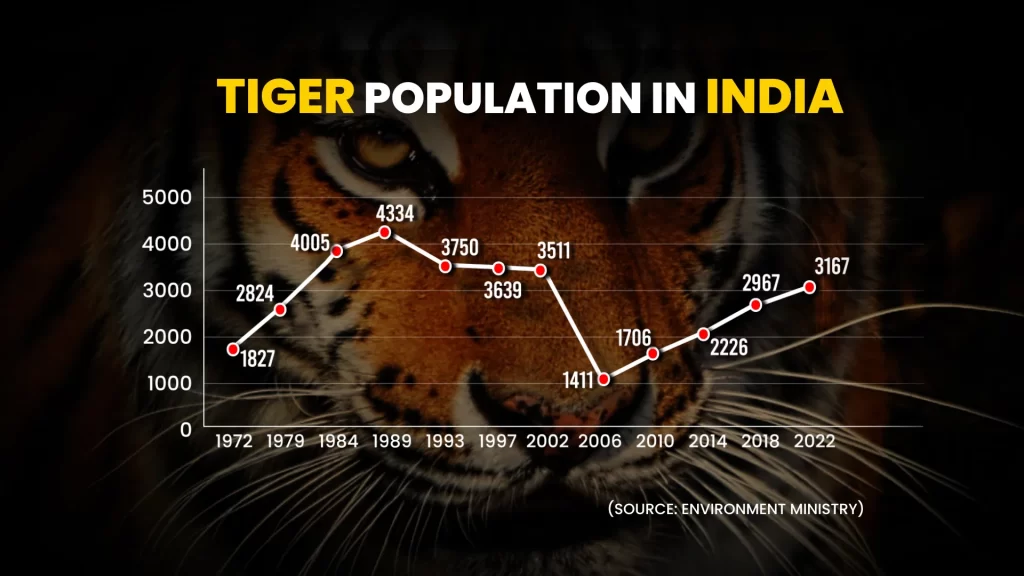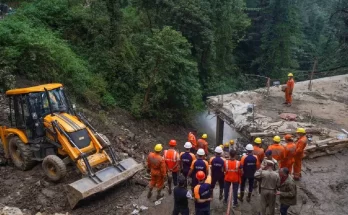Experts are divided over the ideal carrying capacity of tiger habitat.

On April 1, 1973 India launched Project Tiger to save the endangered big cat (Photo credit: Depositphotos)
New Delhi: In the 50th year of Project Tiger, a debate has broken out over how many tigers can India sustain in the wild.
On April 9, at an event to commemorate five decades of Project Tiger, Prime Minister Narendra Modi announced India has 3,167 tigers in the wild.
Now, experts are divided on the appropriate carrying capacity of India’s forests. The ‘Amrit Kal Ka Tiger Vision’ document lists out actions for tiger conservation during the Amrit Kal — the 25-year period between 2022 and 2047 in which India celebrates a century of its Independence — but makes no mention of the tiger population goals.
Multiple factors – prey density, habitat health, water availability – decide the number of tigers an area can sustain. In optimum conditions, one male tiger requires an approximate area of 100 sq km and a female tiger around 75 sq km. If the prey is less, they need to roam a larger area to hunt for food. In simple terms, 2000 kg of prey is needed to sustain a predator of 200 kg in a habitat,” says Md. Sajid Sultan, Assistant Inspector General, NTCA.

NTCA’s Population Habitat Viability Analysis (PHVA) on tiger ecology indicates that an inviolate space of 800-1200 sq km is required for a viable tiger population of 80-100 tigers which should have a minimum of 20 breeding females and a sex ratio skewed towards females.
Dr Rajesh Gopal, former member-secretary, National Tiger Conservation Authority (NTCA), says: “We are very close to the ecological carrying capacity, and I have no hesitation in saying this. At the most we can aspire for another 800 to 1000. So not more than, say, 4000 … not beyond that.”
Ullas Karanth, Emeritus Director at the Centre for Wildlife Studies, on the other hand, says India can sustain between 10,000 and 15,000 tigers. “Well-protected tiger habitats can support tiger population densities of 10-15 tigers per 100 sq km. Government-owned reserved forests, all of which can potentially support tiger populations if protected, extend over 3,80,000 sq km, but only a small fraction is protected well in a few reserves.”
“On an average, if we can attain a density of 5 tigers per square kilometre, in an area of 3,00,000 sq km, we can have 15,000 tigers and in 2,00,000 sq km, we can have 10,000 tigers. That is roughly the potential carrying capacity,” he said.
Project Tiger was launched on April 1, 1973 across nine eco-typical protected areas in nine states. These were designated as ‘Tiger Reserves’.
The tiger population in India rose steadily from just 1,827 in 1972 to more than 4,300 in 1989. However, poaching continued unabated and the numbers started declining till they came down to 3,511 in 2002. In 2006 they hit rock-bottom at 1411. The National Tiger Conservation Authority (NTCA) was formed in 2005 and more than a decade later, the numbers increased to 2,967 in 2018, which increased further to 3,167 in 2022 as per the latest Tiger estimation.
At present India’s tiger area coverage is 75,796.83 sq km, which amounts to 2.3% of the country’s geographic area. Of this, 41,499.37 sq km are core areas (with the status of national park or wildlife sanctuary) and 34,297.46 sq km are peripheral buffer areas.
The 2022 Tiger Estimation report revealed that India’s tiger population had increased substantially in the Shivalik and Gangetic flood plains, followed by Central India, northeastern hills and Brahmaputra flood plains and Sunderbans while that in the Western Ghats had fallen. For central India, however, there was a word of caution: “It is crucial to record that the local tiger population has become extinct in several areas such as the Sri Venkateswara National Park and the Kawal, Satkosia and Sahyadri tiger reserves.”
There was another warning in the Tiger Estimation report for eastern Indian areas. “Serious conservation efforts are needed to help tiger population recovery in Jharkhand, Odisha, Chhattisgarh, Telangana and Andhra Pradesh. The small and genetically unique population of tigers in Simplipal (Odisha) is a priority for conservation,” said the Tiger Estimation Report and also flagged the decrease in tiger occupancy throughout the Western Ghats except a few areas such as Anshi Dandeli reserve in Karnataka.
Karanth said: “Existing tiger reserves cover only 75,000 sq km and only half that area is somewhat protected. Many tiger reserves are almost devoid of tigers. Less than half of the tiger reserve areas at ‘saturation densities’, which is over 10 tigers per 100 sq km.”
States such as Chhattisgarh, Jharkhand and to an extent, Telangana, Odisha and Andhra Pradesh had borne the brunt of Left Wing Extremism (LWE) for more than two decades. Now that it is declining, experts hope that tiger numbers will increase. At the same time, these tiger areas also see some of the densest human populations.
Gopal said: “Even if you pack all your tiger reservoirs and the peripheral areas that they have the dynamics, we cannot have more tigers … you need to read this ecological carrying capacity with the social carrying capacity.”
Karanth disagrees and points out that India has less than 5% of its 32,00,000 sq km land area for nature. “It should be about 10%. The remaining area is sufficient for people to thrive. Are we so selfish to not allow tigers and millions of other species even 10% of our land?”
Along with the Tiger Estimation numbers, Prime Minister Modi released a Amrit Kal Ka ‘Vision Tiger’. Spelling out the ‘Vision’ as “Securing Tigers for Posterity”, the document mentions its goal: “To maintain a viable and sustainable population of tiger in the wild based on carrying capacity of the habitat and to bring all potential tiger habitat under the coverage of Project Tiger.”
The ‘Vision Tiger’ states its objective as: “To ensure maintenance of a viable population of tiger in India for scientific, economic, aesthetic, cultural and ecological values and presence for all times, areas of biological diversity for benefit, education and awareness of the society.”
(This story first appeared on news9live.com on Apr 28, 2023 and can be read here.)



